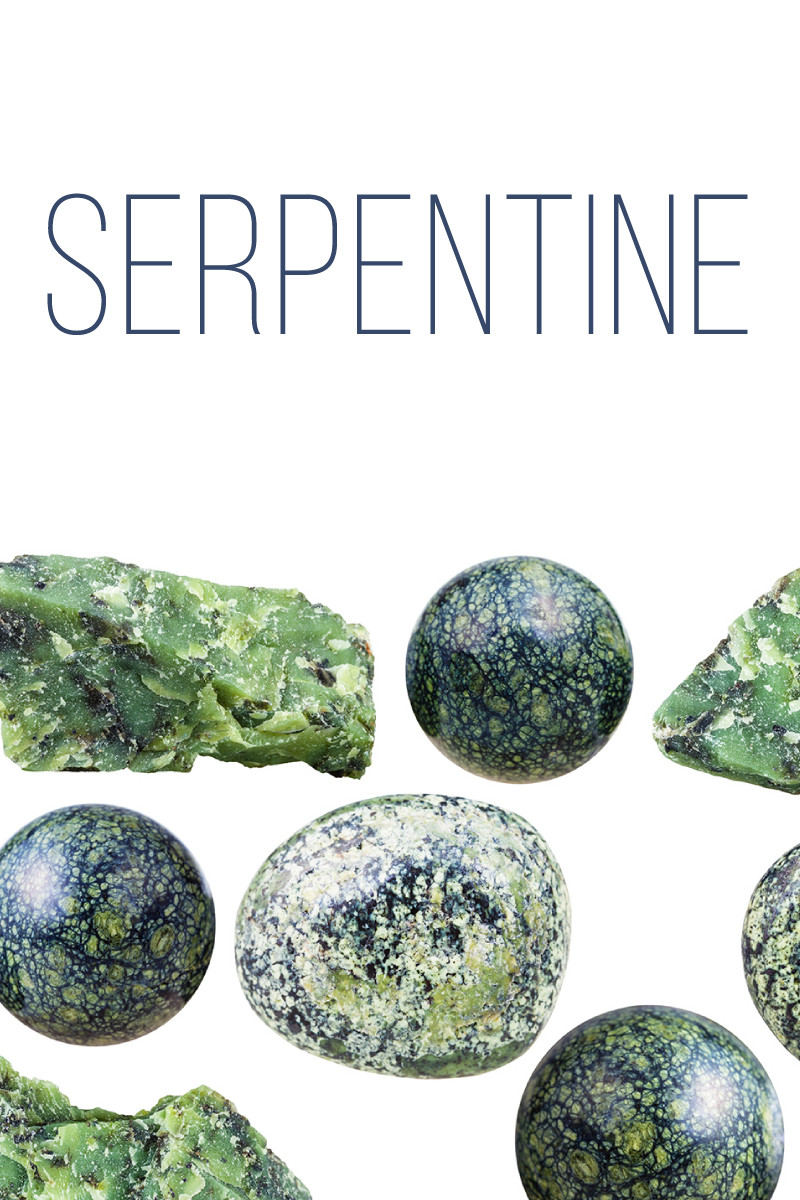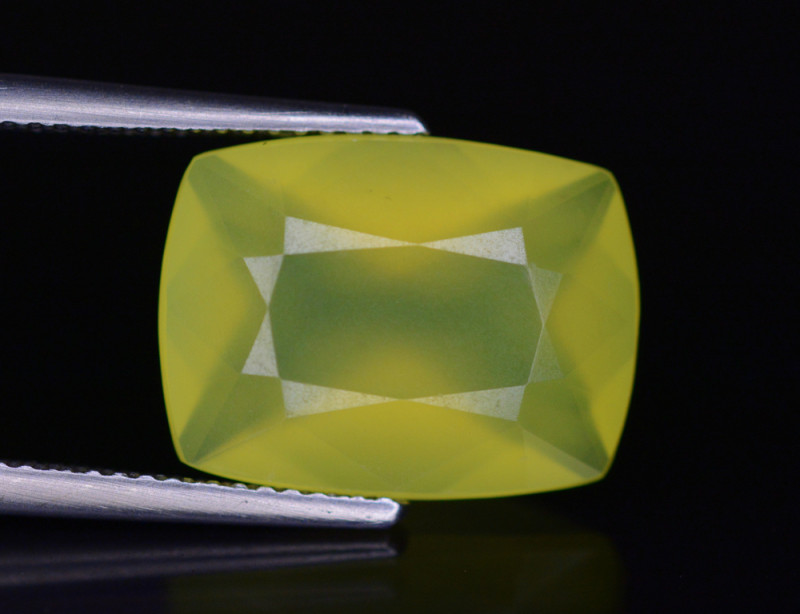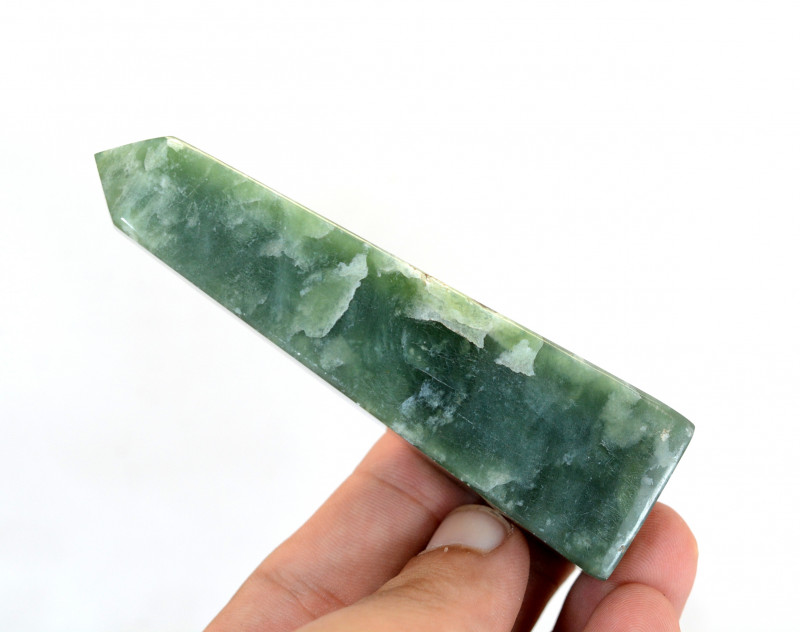
Serpentine Gemstone: Nneɛma, Nkyerɛase, Botae & Nea Ɛkeka Ho
 Serpentine yɛ aboɔden abo a wonim no yiye wɔ wiase a ɛfa aboɔden abo ne ahwehwɛ a wɔboaboa ano a wɔn ani gye ho no mu nanso ɛtaa yɛ nea ɔmanfo nyinaa ani nna hɔ kɛse. Saa aboɔden abo a ne fã kɛse no ara yɛ agude yi da adi wɔ ahabammono ahorow a ɛsono emu biara a ntini ahorow a ɛyɛ nwonwa wɔ aniwa so.
Serpentine yɛ aboɔden abo a wonim no yiye wɔ wiase a ɛfa aboɔden abo ne ahwehwɛ a wɔboaboa ano a wɔn ani gye ho no mu nanso ɛtaa yɛ nea ɔmanfo nyinaa ani nna hɔ kɛse. Saa aboɔden abo a ne fã kɛse no ara yɛ agude yi da adi wɔ ahabammono ahorow a ɛsono emu biara a ntini ahorow a ɛyɛ nwonwa wɔ aniwa so.
Dɛn ne serpentine din mfiase? Ebinom ka sɛ ahwehwɛ no din fi sɛnea ɛte soronko no mu! Ne agyiraehyɛde a ɛyɛ nwonwa ne sɛnea ɛte sɛ nea ɛyɛ hwerɛma no ma yɛkae ɔwɔ. Enti, edin “ɔwɔ!”
Wɔtaa de frafra jade esiane sɛ ɛte sɛ nea ɛte no nti, serpentine ka aboɔden abo ahorow a ɛsono emu biara koraa a ɛne ne ho nni abusuabɔ ho.
Ɛte saa — series! Serpentine nkyerɛ aboɔden aboɔ baako na mmom ɛyɛ aboɔden aboɔ kuo kɛseɛ bi. Saa awɔ mu aboɔden abo yi nyinaa wɔ abusuabɔ, wɔkyɛ nneɛma a ɛte saa ara na ɛnam akwan a ɛte saa ara so na ɛba.
Wopɛ sɛ wuhu pii fa awɔ a ɛyɛ soronko a ɛtoatoa so no ho? Kɔ so kenkan na woatwe wo ho akɔ nea ɛwɔ hɔ a ɛsɛ sɛ wuhu fa ɔwɔ abakɔsɛm, nea ɛkyerɛ, ne su, ne bo, ne nea ɛkeka ho nyinaa mu!

Ɛfa Serpentine Stone ho
Nea edi kan no, dɛn na ɔwɔ yɛ ma? Sɛ ne ayaresa tumi a ɛsakra (ɛka ho asɛm pii kakra) da nkyɛn a, wɔde serpentine di dwuma wɔ agude, adansi, adwinni, ne nea ɛkeka ho mu!
Sɛnea Serpentine te sɛ jade no ma nkurɔfo ani gye ho sɛ wɔde si jade ananmu a ne bo nyɛ den. Ebinom mpo frɛ no “jade foforo” anaa “ɔwɔ jade.” Nanso, serpentine yɛ mmerɛw sen jade ankasa! Edin hunu afoforo bi ne “atoro jade” ne “teton jade.”
Ebia California ɔman aboɔden abo a aban no de di dwuma no yɛ sika kɔkɔɔ , nanso wɔmaa serpentine abodin sɛ ɔman abotan a aban de ma Golden State wɔ 1965 mu.
While it’s not an official zodiac stone , ɔwɔ no ne Gemini nsɛnkyerɛnne hyia wɔ nsoromma mu hwɛ mu. Nea ɔwɔ kyerɛ ma Geminis no yɛ nea ɛfa fam ho. Ne honhom mu wosow betumi aboa ma Gemini su a ɛbɔ abira no kari pɛ.
Nea edi hɔ no, serpentine no mineral su ahorow!

Serpentine Mineral Su ahorow
Bere a ɔwɔ ɔbo a ɛyɛ ahabammono na ɛtaa yɛ nea abu so sen biara no, saa aboɔden abo a ɛsom bo fã yi nso pue wɔ kɔkɔɔ, bruu, bruu, ne fitaa ahorow mu. Abo dodow no ara da chromite anaa magnetite octahedra a ɛka ho a ɛyɛ nsensanee te sɛ ntini adi. Nhwɛsode ahorow bi wɔ magnetite pii araa ma wubetumi de magnet akɔ baabiara!
Nhama ahorow bi (te sɛ chrysotile) tumi ko tia ɔhyew a ɛkɔ baabi foforo, ko tia ɔhyew, na ɛyɛ adwuma sɛ ɔhyew a wɔde siw ɔhyew ano a eye wɔ mfiridwuma mu.
Ɛwom sɛ nneɛma betumi ayɛ soronko wɔ serpentine mineral ahorow mu de, nanso serpentine su ahorow a wɔde di dwuma wɔ ɔkwan a ɛkɔ akyiri so ho nsɛm a wɔaka abom ni:
Nnuru a Wɔde Yɛ Nnuru : (Mg, Fe, Ni) 3Si2O5 (OH) 4
Nneɛma a wɔahyehyɛ : Silicate
Mohs hardness : Ɛwɔ 3 kosi 5 ntam, nanso ɛsono
Kɔla : Kɔla ahorow a ɛsonosonoe a ɛyɛ ahabammono, kɔkɔɔ, tuntum, fitaa, ne kɔla afoforo
Ahwehwɛ nhyehyɛe : Monoclinic; microcrystalline a ɛyɛ fɛ
Luster : Ɛyɛ Waxy, Resinous, Srade, Silky, Dull
Transparency : Ɛyɛ translucent kosi opaque, ɛntaa nsi
Nneɛma a ɛma hann yɛ hyew : 1.56 kosi 1.57
Density : 2.5 kosi 2.6
Cleavage : Ohiani kosi pɛ; Ɛtɔ mmere bi a, obiara nni hɔ
Fracture : Ɛyɛ granular, ɛnyɛ pɛpɛɛpɛ
Streak : Ɛyɛ fitaa
Luminescence : Ɛhyerɛn a ɛma hann; Inert kosi bruu a ɛyɛ mmerɛw wɔ SW-UV mu, Inert kosi ahabammono a ɛyɛ mmerɛw wɔ LW-UV mu

Serpentine Ahorow Ahorow
Bere a awɔ akuw nketewa no wɔ nneɛma a wɔahyehyɛ no yɛ pɛ no, wɔn su ahorow no wɔ nsakrae bi. Wɔtaa ba a wɔadi afra sɛ abotan. Sɛ wotwa a, wɔka ne nyinaa ho asɛm sɛ “ɔwɔ,” nanso ɛsono wɔn wɔ akwan horow so.
Antigorite a wɔfrɛ no Antigorite
Antigorite ne nsakrae a ɛtaa yɛ afã horow. Ɛyɛ ɔwɔ kɔkɔɔ sen ahabammono na ɛwɔ asasepɔn biara so, a Antarctica ka ho.
Bowenite na ɔkyerɛwee
Bowenite yɛ antigorite ahorow a ɛyɛ hann na ɛtaa pue wɔ bruu-ahabammono, kɔkɔɔ-ahabammono, anaa ahabammono tuntum mu. Ɛsan nso yɛ serpentines no mu nea ɛyɛ den sen biara. Wɔahu nneɛma a wɔde asie a ɛda nsow wɔ Afghanistan, China, New Zealand, South Africa, ne United States.
Chrysotile a wɔde yɛ aduru
Chrysotile yɛ nhama a ɛyɛ nhama na ɛyɛ asbestos a wohu wɔ wiase nyinaa fibea. Ebetumi ayɛ fitaa, fitaa, kɔkɔɔ, bruu, ne ahabammono.
Healerite a ɔyɛ ɔyaresafo
Healerite, anaa ɔwɔ a ɛkorɔn no yɛ ɔwɔ a ɛyɛ mmerɛw a ɛyɛ ahabammono a ɛte sɛ lime na ɛyɛ nsakrae a wɔahu nnansa yi. Efi Washington State mmepɔw a ɛwɔ USA Atifi fam Atɔe so.
Ɔkraman a ɔyɛ ɔkraman
Lizardite ne ɔwɔ ahorow a abu so sen biara na wɔde din too Lizard Peninsula a ɛwɔ Cornwall, England baabi a wodii kan huu no no. Lizardite ka chrysotile ne antigorite ho sɛ ɔwɔ mu nneɛma atitiriw abiɛsa no mu biako.
Verd Tete Nneɛma a Wɔde Yɛ Nneɛma
Wohu verd antique wɔ Egypt, Greece, Italy, ne Vermont (U.S.A.), na ɛyɛ aboɔden abo a ɛyɛ ahabammono a wɔde serpentine, calcite , dolomite, ne magnesite ayɛ.
Williamsite a ɔkyerɛwee
Wɔde nea ohui (Lewis White Williams) din too williamsite so, na ɛyɛ antigorite ahorow foforo a ɛyɛ hann. Mpɛn pii no ɛyɛ apɔw-mu-teɛteɛ a chromite ahwehwɛ a ɛyɛ tumm a ɛte sɛ octahedral ne magnesium hydroxide fitaa a ɛwɔ afã horow.
Bere a yɛrekɔ so no, momma yɛnhwɛ serpentine akwantu a ɔfaa abakɔsɛm mu!

Serpentine Nkyerɛase & Abakɔsɛm
Germanni aboɔden abo ho ɔbenfo Georgius Agricola (Georg Bauer) na ɔtoo Serpentine din wɔ 1564. Edin no fi Latin serpens (a ɛkyerɛ “ɔwɔ”) mu esiane sɛ ɔbo no yɛ ahabammono a ɛyɛ nsensanee a ɛte sɛ ɔwɔ were nti.
Ná wobu Serpentine kɛse wɔ Tete Misraim, Persia, ne Asiria esiane sɛ na ɛhyerɛn fɛfɛɛfɛ nti. Ná agye din wɔ agude, ofie asiesie, ne nyamesom afɔrebɔ mu. Ná wɔtaa hyɛ ɔwɔ pendants de ko tia ahoɔden bɔne na wɔbɔ wɔn ho ban fi awɔ a wɔbɛka wɔn ho. Nea na agye din kɛse mpo ne sɛnea wɔde agude a wɔde di dwuma wɔ adwini ne ahoni a wɔde siesie nneɛma mu no.
Wɔ Punjab mantam mu wɔ Asia Kesee Fam Apuei , na wɔde serpentine siesie kurom hɔfo akode. Saa ara nso na na Maori mmusuakuw a wɔwɔ New Zealand no de ɔwɔ ayɛ adwene a wɔde kyekyere ntama ne agude. Ná Aztekfo anibuei nso bu no kɛse.
Bere bi na wɔde nhama ahorow te sɛ chrysotile yɛ asbestos de yɛ mfiridwuma pii . Nanso esiane sɛ ɛne ɔhome mu yare wɔ abusuabɔ nti, wɔagyae asbestos dodow no ara pɛnhyen. Ɛnnɛ, wɔde serpentine di dwuma titiriw wɔ agude ne nsusuwso mu.
Enti, ɛyɛɛ dɛn na serpentine nyaa California ɔman abotan no anuonyam ? Ɛnyɛ sɛ ɛdɔɔso wɔ mpɔtam hɔ ne sɛnea wɔde di dwuma wɔ mfiridwuma mu nti na enyaa anuonyam no, na mmom esiane nneɛma pa a ɛyɛ ma asase no nyinaa nti.
Serpentine tumi fa afifide a wɔntaa nhu na ɛyɛ soronko. Bio nso, ɛde ayaresa kɔ okyinnsoromma yi so denam mframa a ɛma wim yɛ hyew a ɛtew so denam carbon a ɛtwetwe so. Good-bye, wim tebea ho haw — Hello, Ɛna Asase a ɔhwɛ ne ho so!
Wɔ metaphysics mu no, dɛn na ɔwɔ kyerɛ?

Serpentine Ayaresa Nneɛma
Te sɛ ahwehwɛ dodow no ara no, sɛnea ɔwɔ no yɛ ne sɛnea ɛwɔ abɔde mu nneɛma mu no ma ɛyɛ ɔbo a ano yɛ den a ɛsa yare .
Sɛnea ɛte wɔ ahwehwɛ a ɛyɛ ahabammono dodow no ara ho no , serpentine yɛ ɔbo a ɛyɛ asase mu nneɛma. Ne kɔla a ɛyɛ ahabammono no yɛ yiyedi, nkɔso, fam, ne Asase Ɛna ho sɛnkyerɛnne.
Kɔ so kenkan na woahu sɛnea ɔwɔ so mfaso wɔ w’adwene, wo nipadua, ne wo honhom mu!
Nipadua mu Ayaresa
Wɔ nipadua mu ayaresa ho no, serpentine betumi aboa ma asikreyare ne asikreyare a ɛba fam no so atew.
Ne ahotew ahoɔden betumi ayɛ awuduru kɛse ama nipadua ne mogya — aboa ma woayi mmoawa a wɔsɛe nnɔbae ne mmoawa afi hɔ. Ebia ɛbɛboa nso ma wo nipadua no atwe calcium ne magnesium.
Nkate mu Ayaresa
Sɛ wɔde di dwuma wɔ nkate fam a, serpentine yɛ ade a ahwehwɛ ayaresafo ani gye ho kɛse sɛ ahobammɔ ho sɛnkyerɛnne. Wɔkyerɛ sɛ ne fekubɔ ne awɔ no ma ahoɔden a ɛbɔ wo ho ban twa nipadua ne honhom no ho hyia — ɛma wutumi di nneɛma a woatumi ayɛ a wode ato nkyɛn no akyi.
Ebinom ka sɛ ɔwɔ a wobɛma abɛn wo no boa ma wodan nsusuwii ne nneyɛe a ɛnteɛ ma ɛbɛyɛ nea eye.
Chakra Ayaresa
Aboɔden abo bi betumi aboa ma chakra ahorow ason (anaa ahoɔden nsɛntitiriw) a ɛwɔ wo nipadua mfinimfini no akari pɛ. Bere a wobetumi de serpentine adi dwuma sɛ chakra ɔbo ama wo chakral nipadua nyinaa no, ɛne koma chakra no hyia titiriw.
Koma chakra no ne ɔdɔ, ayamhyehye, ne ayaresa wɔ abusuabɔ. Serpentine betumi aboa ma woabue chakra no ma ama woanya kommyɛ, asomdwoe, ne wo ho dɔ.
Seesei a wunim mfaso a ɛwɔ serpentine crystal so nyinaa no, ma yɛnhwɛ nneɛma a ɛwɔ ne bo mu!

Serpentine Aboɔden abo Nneɛma a Ɛwɔ Hɔ
Serpentine bo a ɛsom no fi nneɛma a wɔahyɛ da ayɛ te sɛ kɔla, nea wɔatwa, nea emu da hɔ, ne emu duru mu.
Ahosuo
Abo a ɛte sɛ ɔwɔ gu ahorow wɔ ahabammono mu nanso ɛtɔ mmere bi a ɛda adi wɔ kɔla ahorow a ɛyɛ fitaa, kɔkɔɔ, fitaa, bruu, anaa tuntum mu. Aboɔden abo dodow no ara yɛ ntini anaasɛ nsensanee na ebetumi ada mmeae a chatoyancy (ɔkraman aniwa nkɛntɛnso) wɔ, a ebetumi ayɛ te sɛ nea ɛyɛ hann anaasɛ ɛyɛ sum a egyina sɛnea wohwɛ no so.
Twa
Ɛwom sɛ ɛyɛ aboɔden abo a ɛyɛ mmerɛw kakra de, nanso wobetumi atwitwa serpentine ayɛ no nsusuwii ahorow na wɔde adi dwuma wɔ agude a enni nkɛntɛnso kɛse te sɛ asomuade anaasɛ pendants mu. Mpɛn pii no, lapidaries twitwa serpentine ma ɛyɛ cabochons , nhwiren, ne nneɛma a wɔde asiesie. Ahorow bi (te sɛ williamsite) yɛ nea ɛyɛ hann araa ma ɛyɛ nea ɛwɔ afã horow .

Ɛda adi pefee
Mpɛn pii no, Serpentine yɛ nea ɛyɛ hann kosi nea ɛnyɛ hann na ɛntaa nyɛ nea ɛyɛ fã bi. Calcite ne nneɛma afoforo a ɛka ho wɔ aboɔden abo dodow no ara mu . Nneɛma a wɔde ka ho no ma ntini fitaa anaa tuntum, marbling, anaasɛ nsensanee. Dodow a nsusuwso no yɛ nwonwa no, dodow no ara na aboɔden abo no yɛ nea wɔpɛ.
Carat Mu duru & Ne Kɛse
Serpentine taa ba bere nyinaa wɔ mmeae akɛse na akyiri yi lapidaries twa no. Sɛ yɛhwɛ ne kɛse a, mpɛn pii no, ɔwɔ aboɔden abo mu duru yɛ carat. Ɔkwan foforo so no, awɔ a wɔasen ne nsusuwso tumi gu ahorow wɔ susuw mu na wobetumi atɔn no sɛnea ne kɛse te mmom sen sɛ wɔbɛtɔn no sɛnea emu duru te.
Ayaresa ahorow
Wɔde ayaresa ahorow abien na ɛyɛ ɔwɔ abo: wɔde resin (na ama atumi agyina pintinn) ne aduru a wɔde yɛ (na ama kɔla atu mpɔn).
Nnuru a ɛyɛ ahabammono ma wɔn ho yɛ fɛ “te sɛ jade” no, nanso ebetumi nso ayɛ nwini a ɛboro ahabammono serpentine abɔde mu nneɛma so, te sɛ borɔdɔma ne kɔkɔɔ. Saa nneɛma a wɔde kɔla ayɛ yi betumi asuasua aboɔden abo afoforo a jade nka ho, te sɛ sugilite .
Enti ɔkwan biara so no, ɔkwan bɛn so na wɔhyehyɛ ɔwɔ? Momma yenhu!

Serpentine Formation & Nneɛma a Wɔde Yɛ Adwuma
Nea edi kan no, so ɔwɔ ɔbotan? Aane! Wiɛ, ɔkwan bi so.
Wɔ mfiridwuma mu no, serpentine ne ogya abotan a magnesium pii wom a efi Asase atifi no nkae a asakra. Saa abotan a ɛyɛ ultramafic yi (a ɛtaa yɛ peridotite anaa dunite) fa nsuo a ɛyɛ hyew mu nsakraeɛ mu wɔ mprɛte hyeɛ a ɛne ne ho hyia.
Wɔ saa nsakrae yi mu no, aboɔden abo te sɛ olivine ne pyroxene dane yɛ serpentine mineral. Ɛkame ayɛ sɛ abotan a ɛsakrasakra a wɔyɛ no bi a wɔfrɛ no serpentinites no nyinaa yɛ serpentine minerals.
Asase ani fã kɛse no ara wɔ serpentinites atifi pɛɛ! Saa mmeae yi ba bɛn mprempren anaa tete convergent tectonic plate hye a ɛpo mprɛte nkae da adi wɔ asase ani. Wɔtow saa nkae yi kɔ soro, wonyinii wɔ asase bi ano anaasɛ wim tebea a ɛsakrae na ɛtetee wɔn.
Mpɛn pii no, mmeae a ɛpo mu mprɛte a ɛda adi yi (a wonim no sɛ ophiolites) wɔ no yɛ mmeae a aboɔden abo te sɛ magnetite, chromite, chrysoprase , jade, ne nokwarem no, serpentine wɔ!
Mmeae a Wɔtu Tuo
Ɛhe na wohu ɔwɔ?
Wobetumi ahu nneɛma akɛse a wɔde asie wɔ Greece, Cyprus, ne mmepɔw a ɛwɔ Russia, New Zealand, Austria, France, Italy, ne U.S
Mpɔtam afoforo bi a ɛda nsow wɔ wiase nyinaa ne:
Afghanistan
Australia
Brazil
Canada
China
Congofoɔ
India
Madagascar
Pakistan
South Africa
United Kingdom na ɛwɔ hɔ
Wɔhyɛ wo sɛ tɔ w’ankasa ɔwɔ aboɔden abo? Nea wobɛhwɛ kwan wɔ sikasɛm nhyehyɛe mu ni!

Serpentine Abo Bo & Ne Bo
Esiane sɛ serpentine yɛ mineral a abu so na ɛdɔɔso wɔ mmeae pii nti, ne bo nso yɛ nea ɛfata.
Aboɔden abo nketewa a wɔatwitwa no kurukuruwa te sɛ cabochons betumi ayɛ dɔla 0.20 kosi dɔla 2.74 wɔ carat biara mu. Beads betumi ayɛ bɛyɛ $0.07 kosi $0.26 wɔ carat biara mu.
Agude bo gu ahorow. Mpɛn pii no, nkaa taa wosow fi dɔla 36 kosi dɔla 70, nanso ebinom tumi nya ne bo a ɛkɔ soro kodu dɔla 136. Nkapo a wɔde nhwiren ayɛ no bo yɛ dɔla 2.50 kosi dɔla 40.
Serpentine a wɔantwitwa (anaasɛ nea wɔannoa) betumi agye dɔla 0.41 kosi dɔla 0.89 wɔ carat biako mu.
Enti awiei koraa no woanya “ɔwɔ jade” bi a wode bɛka wo ahwehwɛ a woaboaboa ano no ho! Momma yɛmfa ɔwɔ aboɔden abo hwɛ bi nwie !
Serpentine Hwɛ ne Nsiesiei
Serpentine yɛ mineral a ɛyɛ mmerɛw na ɛyɛ mmerɛw — araa ma ofie mfutuma mpo betumi ama ayɛ mmerɛw.
Ɛsɛ sɛ abo a wɔde yɛ ring di dwuma de ahobammɔ nhyehyɛe bi di dwuma na ama wo aboɔden abo no atra hɔ akyɛ.
Sɛ wopɛ sɛ wo serpentine crystals nkwa nna tenten a, kwati:
Nnuru a ano yɛ den
Nnuhwam/nneɛma a wɔde yɛ ahosiesie
Nneɛma a wɔde tew nneɛma ho a wɔde ultrasonic yɛ
Nsu a ɛyɛ hyew a wɔde tew nneɛma ho
Aboɔden abo a ɛyɛ abrasive
Ɔhyew a ɛsakra mpofirim
Ntama a wɔhyɛ bere a wɔreyɛ dwumadi ahorow a ɛyɛ mmerɛw sɛ ɛbɛbɔ
Sɛ wopɛ sɛ wohohoro a, fa samina a ɛnyɛ den ne nsu di dwuma. Fa ntama a ɛyɛ mmerɛw a wɔansiesie no brɛoo pat dry. Dry yiye na fa sie wɔ kotoku a ɛbɔ ho ban mu a ɛnyɛ aboɔden abo a ɛyɛ den anaasɛ asiane a ɛwɔ hɔ sɛ ɛbɛka no.

Hwie Bad Vibes no gu ne Serpentine!
Sɛnea ɔwɔ hwie ne were gu no, saa ara na serpentine boa wo ma wohwie ahoɔden bɔne gu na ɛde vibes foforo a ɛyɛ papa si ananmu na ama woakɔ so ayɛ adwuma. Sɛ ne metaphysical tumi ahorow da nkyɛn a, serpentine kɔ so yɛ ade a ɛma wogyae ɔyɛkyerɛ wɔ adwinni mu ahoni ne agude a ɛyɛ biako pɛ mu.
Sɛ́ ebia worehwehwɛ sɛ wobɛsakra w’ahunmu, honhom, anaa n’abien nyinaa no , ebia ɔwɔ yɛ ahwehwɛ a emu nna hɔ a na wunnim sɛ wuhia no ara kwa!
搜尋Gemstone Encyclopedia
相關拍賣
相關文章
Momma yɛnkyerɛkyerɛ sɛnea wɔtɔ aboɔden abo wɔ intanɛt so. Yɛwɔ aboɔden aboɔ a ɛso sen biara wɔ intanɛt so na ɛbɛtumi ayɛ den kakra wɔ mfitiaseɛ no. Ma yɛmfa afotu bi a mfaso wɔ so mmoa wo.
3rd Oct 2018
W’aboɔden abo a wobɛhwɛ so no boa ma ɛyɛ fɛ wɔ wo nkwa nna nyinaa mu. Yɛbɛka nneɛma te sɛ denden ne ayaresa ho asɛm, ne anammɔn a ɛfa sɛnea wobɛhohoro wo aboɔden abo na wode asie dwoodwoo ho.
9th May 2018
So woasusuw sɛnea wɔyɛ Ruby aboɔden abo ho pɛn? Ayaresa ahorow pii wɔ gua so na yɛbɛboa ma yɛakyerɛkyerɛ mu
9th May 2018
最新的文章
Nnua a wɔde asonse a wɔasen a wɔsan frɛ no nhabannuru asonse no yɛ abɔde mu ade a wɔde si asono asonse ananmu, na wotwa fi Amerika Kesee Fam phytelephas nnuadewa mu nnuadewa mu wɔ abrabɔ pa mu. Sua mmɛw asonse ho ade nyinaa wɔ akwankyerɛ yi mu!
15th Jan 2026
Chrysanthemum nhwiren abo yɛ abɔde mu anwonwade a ɛwɔ calcite, celestite, anaa andalusite nhwiren fitaa bi a wɔde asisi limestone tuntum anaa atɛkyɛ abo so.
13th Jan 2026
Rainbow lattice sunstone yɛ feldspar ahorow a ɛwɔ optical nsunsuanso abiɛsa fɛfɛ a efi nneɛma ahorow a wɔde ka ho a ɛwɔ hɔ no mu ba. Ɛyɛ ogya kɔla display ne lattice nsusuwso ma ɛyɛ coletor abohene a wɔntaa nhu!
12th Jan 2026
文章類別
How To's is where you will find helpful articles from gem Rock Auctions on how to cut gemstones, select gemstones and buy gemstones.
9文章





